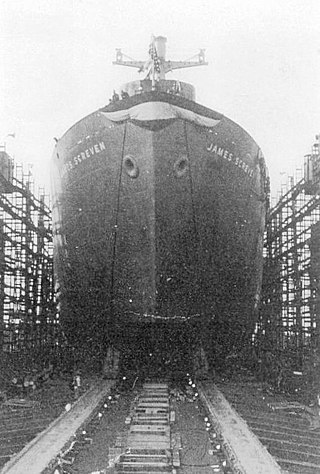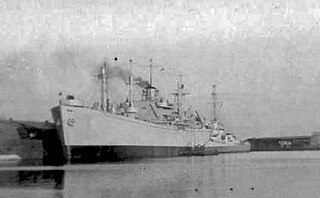USS Talita (AKS-8), an Acubens-class stores ship, is the only ship of the United States Navy to have this name.

USS Graffias (AF-29), a Hyades-class stores ship, is the only ship of the United States Navy to have this name. The name Graffias is another name for the star Beta Scorpii in the constellation Scorpius.

USS Acubens (AKS-5) was an Acubens-class general stores issue ship commissioned by the U.S. Navy for service in World War II, named after the star Acubens, the alpha star in Cancer. She was responsible for delivering and disbursing goods and equipment to locations in the war zone.
USS Alderamin (AK-116) was a Crater-class cargo ship commissioned by the U.S. Navy for service in World War II, named after Alderamin, the alpha star in constellation Cepheus. She was responsible for delivering troops, goods and equipment to locations in the war zone.

USS Shaula (AK-118) was a Crater-class cargo ship, converted from a Liberty Ship, commissioned by the US Navy for service in World War II. She was first named after James Screven, an American general during the American Revolutionary War. She was renamed and commissioned after Shaula, the second-brightest star system in the constellation of Scorpius. She was responsible for delivering troops, goods and equipment to locations in the war zone.

USS Ascella (AK-137) was a Crater-class cargo ship commissioned by the US Navy for service in World War II. Ascella was named after Ascella, a star in the constellation Sagittarius. She was responsible for delivering troops, goods and equipment to locations in the Asiatic-Pacific Theater.

USS Brevard (AK-164) was an Alamosa-class cargo ship commissioned by the U.S. Navy for service in World War II. She was responsible for delivering troops, goods and equipment to locations in the war zone.

USS Castor (AKS-1) was a Castor-class general stores issue ship commissioned by the U.S. Navy for service in World War II. She was responsible for delivering and disbursing goods and equipment to locations in the war zone.

USS Luna (AKS-7) was a Liberty ship built in the United States during World War II. She was originally named for Harriet Hosmer, a neoclassical sculptor, considered the first female professional sculptor. She was converted shortly after completion to an Acubens-class general stores issue ship and renamed Luna, the latin name for the Moon. She was responsible for delivering and disbursing goods and equipment to locations in the war zone.
USS Volans (AKS-9) was an Acubens-class general stores issue ship commissioned by the U.S. Navy for service in World War II. She was responsible for delivering and disbursing goods and equipment to locations in the war zone.

USS Cybele (AKS-10) was an Acubens-class general stores issue ship commissioned by the U.S. Navy for service in World War II. She was responsible for delivering and disbursing goods and equipment to locations in the Pacific war zone. The vessel was launched on 9 October 1944 by Delta Shipbuilding Co., New Orleans, Louisiana and entered service with the U.S. Navy on 16 April 1945. The vessel was decommissioned on 22 August 1946 and transferred to the Maritime Commission for disposal on 24 April 1947. The vessel was scrapped in 1965.

USS Gratia (AKS-11) was an Acubens-class general stores issue ship commissioned by the U.S. Navy for service in World War II. She was responsible for delivering and disbursing goods and equipment to locations in the war zone.

USS Hecuba (AKS-12) was an Acubens-class general stores issue ship commissioned by the U.S. Navy for service in World War II. She was responsible for delivering and disbursing goods and equipment to locations in the war zone.

USS Hesperia (AKS-13) was an Acubens-class general stores issue ship commissioned by the U.S. Navy for service in World War II. She was responsible for delivering and disbursing goods and equipment to locations in the war zone.
USS Iolanda (AKS-14) was an Acubens-class general stores issue ship commissioned by the U.S. Navy for service in World War II. She was responsible for delivering and disbursing goods and equipment to locations in the war zone.

USS Adria (AF-30) was an Adria-class stores ship in service with the United States Navy from 1944 to 1954. She was scrapped in 1977.

USS Buckingham (APA-141) was a Haskell-class attack transport in service with the United States Navy from 1945 to 1946. She was scrapped in 1974.

USS Basilan (AG-68) was a Basilan-class miscellaneous auxiliary acquired by the U.S. Navy during World War II. The ship was designed as a combined barracks-stores-water distillation ship, but was later converted to an electronics repair ship. She spent her Navy career in the Pacific Ocean theatre of operations.
USS Proton (AG-147/AKS-28) -- also known as USS LST-1078 – was an LST-542-class tank landing ship launched by the U.S. Navy during the final months of World War II. Proton served as a troop ship, a cargo ship and as an electronic parts supply ship for the U.S. Pacific Fleet and was decommissioned following the Korean War.
USS Chimon (AG-150/AKS-31) – also known as USS LST-1102 -- was an LST-511-class tank landing ship launched by the U.S. Navy during the final months of World War II. Chimon served as a transport and stores ship for the U.S. 7th Fleet, and was decommissioned after service in the Korean War.















